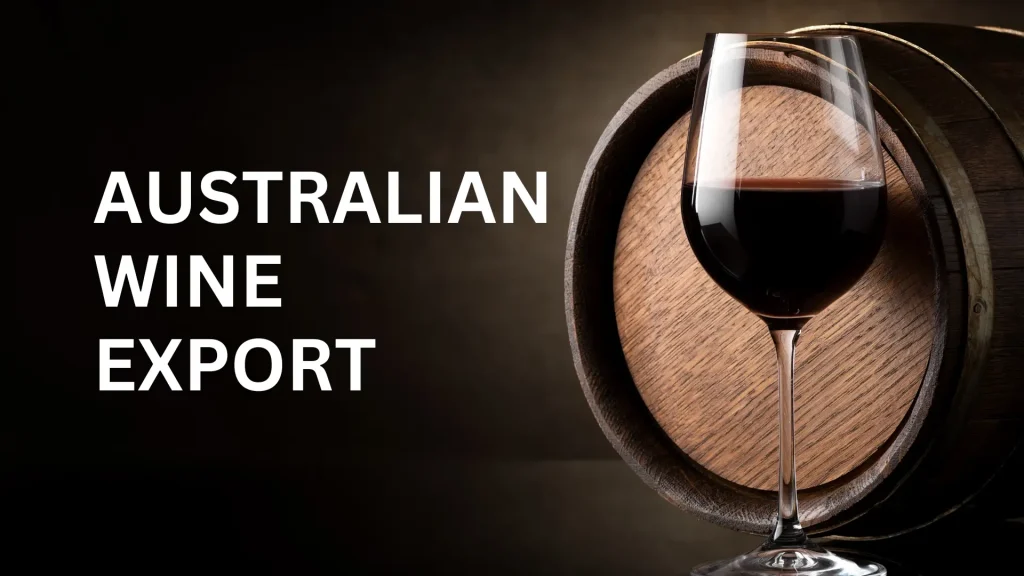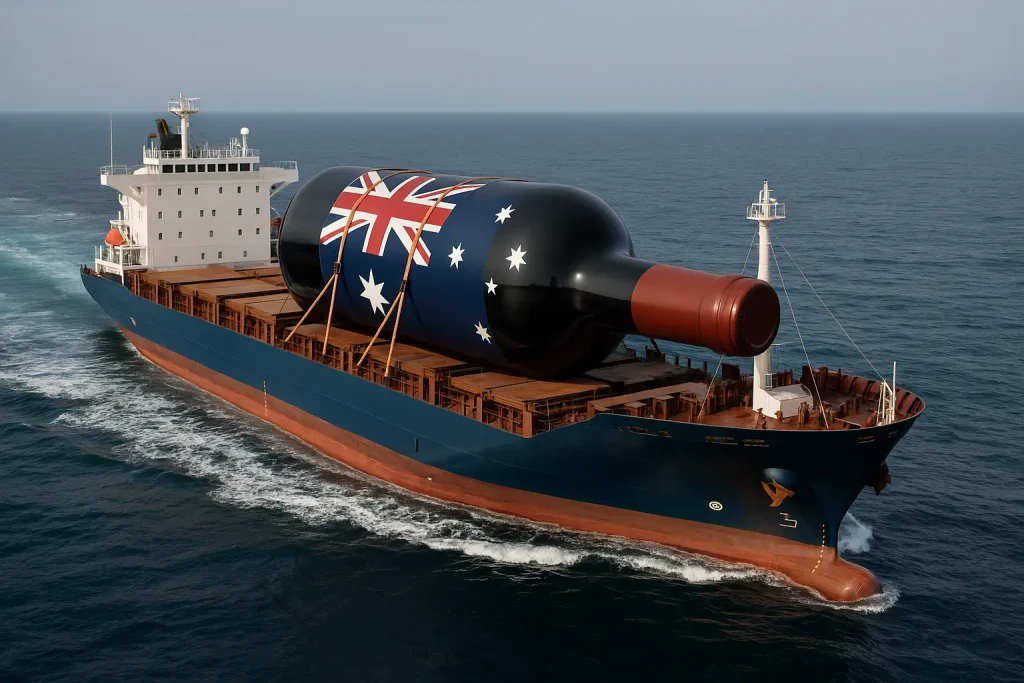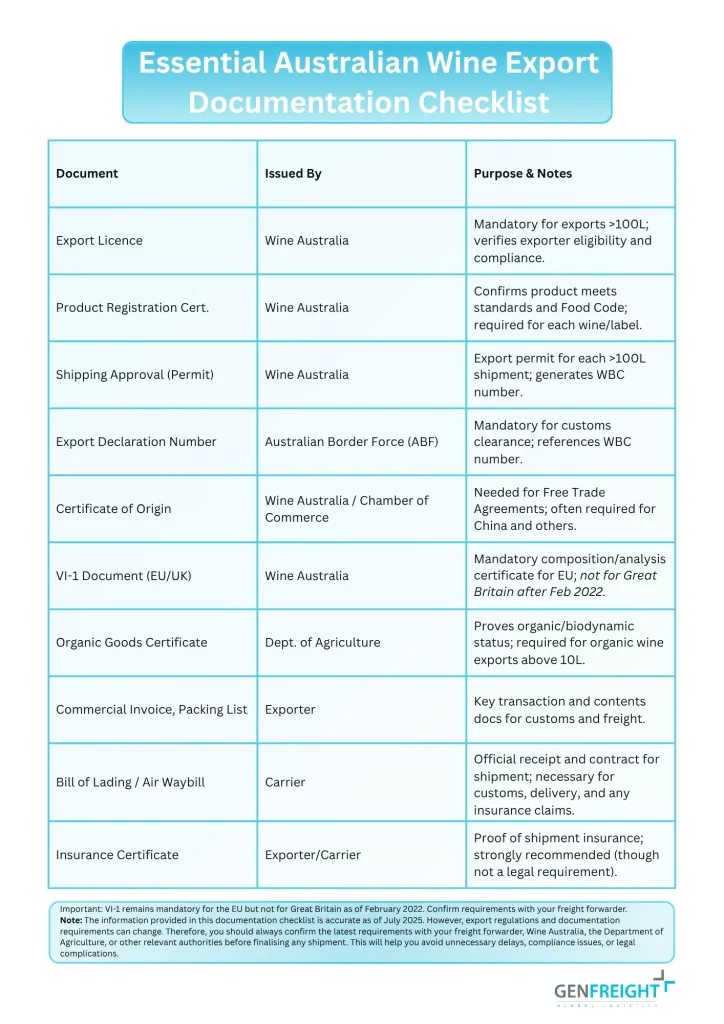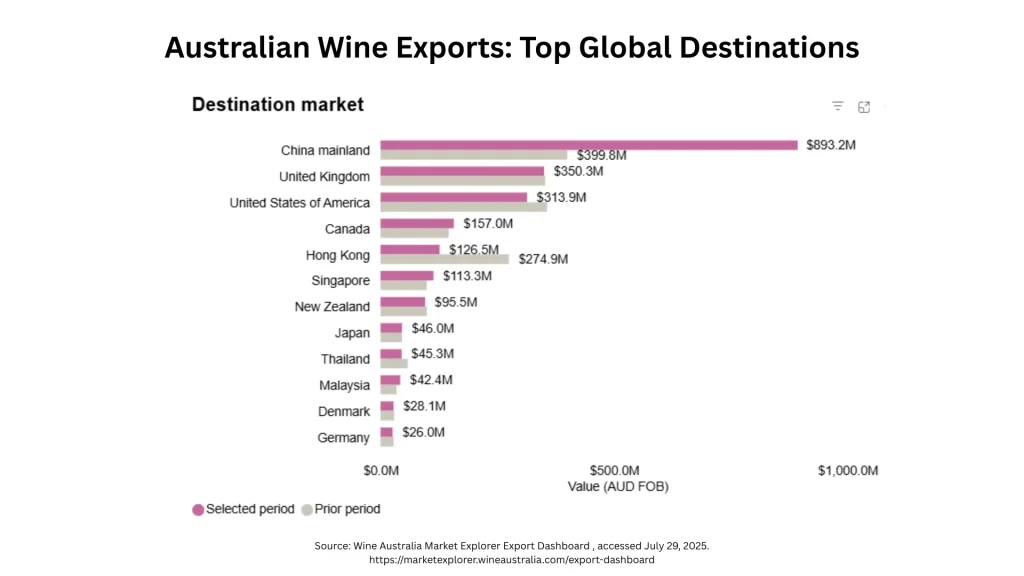Australia’s vibrant vineyards aren’t just beautiful landscapes — they’re the source of world-class wines now enjoyed across the globe. Moreover, global demand for Australian wine remains strong, driven by exceptional quality, diversity, and sustainability. From bold Shiraz to crisp Chardonnay, Australian wines cater to evolving consumer tastes while maintaining a reputation for reliability and innovation.
The Australian wine export market is currently navigating a dynamic period of transformation. According to Wine Australia’s latest Export Report (June 2025), exports increased by 13% in value to $2.48 billion and 3% in volume to 639 million litres. Moreover, the average value per litre hit $3.88 FOB, highlighting strong demand for premium wines. (Source: Wine Australia Export Report, 12 months ended June 2025)
While these figures paint a bright picture, it’s essential to understand the nuances of the global market:
- China’s Return: While China’s market has reopened and driven much of the overall increase, the initial surge in exports after tariffs were removed has now eased.
- Slowdown in Other Markets: Exports to the rest of the world (excluding China) actually declined by 11% in value and 6% in volume. This includes major markets like the UK and, notably, the United States.
- US Relationship & Tariffs: Shipments to the US continue to decline due to factors like high stock levels and market uncertainty. Furthermore, a new 10% import tariff on certain Australian wines in April 2025 adds another layer of cost, which could significantly impact retail prices there.
- Global Challenges: Health trends, rising living costs, and too much wine supply worldwide are all affecting the market.
Even with these challenges, there are still plenty of opportunities for businesses that focus on premium products and take the time to understand their target markets.

Your One-Stop Guide to Exporting Australian Wine
The allure of Australian wine is undeniable. However, getting it from the vineyard to international customers involves much more than just bottling and shipping. Additionally, it requires navigating a precise dance of logistics, compliance, and documentation — all of which can seem daunting. Especially if you’re new to the world of alcohol exports or global freight.
That’s exactly where this guide comes in. Moreover, it’s designed to be your one-stop resource, giving you a clear, practical, and step-by-step roadmap for successfully exporting Australian wine.
In This Guide, You’ll Learn:
- The essential regulations governing wine exports from Australia
- The key documentation and certificates required
- Shipping methods best suited to wine logistics
- Tips for smooth customs clearance at home and abroad
- Common pitfalls to avoid throughout the export process
With the right knowledge and preparation, however, your business can confidently tap into this thriving and dynamic global market.
Step-by-Step Guide to Legal Australian Wine Export
Exporting wine from Australia is a structured process with no shortcuts. Moreover, every step — from selecting the right producer to securing permits and selecting shipping options — must be followed meticulously.
Below is your practical, step-by-step roadmap to navigate this journey successfully.
Step 1: Understand Key Regulatory Authorities
Before anything else, it’s important to know who governs Australian wine exports. These bodies set the rules you must follow:
- Wine Australia: This is the primary regulator for wine exports. Moreover, they issue the licences, export approvals, and supporting documents that are mandatory for any commercial shipment.
- Australian Border Force (ABF): This authority manages customs declarations and inspections at the border.
- Department of Agriculture: For exporters of organic or biodynamic wines, this department provides the necessary Organic Goods Certificates.
Step 2: Partnering with the Right Australian Wine Producer
Your export journey truly begins with the wine itself and the producer behind it. In other words, choosing the right partner here is paramount to your success.
When selecting an Australian wine exports producer, consider these key factors:
- Export-Ready Producers. Firstly, choose wineries that already export — they’ll understand both process and quality expectations.
- Certifications & Compliance:
- Label Integrity Program (LIP). Secondly, it’s critical that the wine producer adheres to Wine Australia’s Label Integrity Program (LIP). This program is designed to ensure that claims made about the wine’s vintage, grape variety, and geographical indication (GI) on the label are accurate and legally compliant. Basically, it guarantees what’s on the label is true.
- Food Standards Code. Additionally, the wine itself must meet the strict standards set out in the Australian Food Standards Code. This includes regulations on permissible additives and general labelling requirements, ensuring the wine is safe and accurately represented for consumption.
- Quality Control. Finally, ensure the winery has robust quality controls in place to protect wine quality during production, storage, and transit.
Step 3: Navigating Australian Export Requirements (Via Wine Australia)
Exporting legally means following a precise sequence of approvals through Wine Australia’s WALAS system.
1. Obtain an Export Licence
- This is your very first mandatory step for any wine shipment exceeding 100 litres.
- You’ll need to apply for this through the Wine Australia Licensing and Approval System (WALAS).
- Additionally, the application process will involve an assessment of your business’s standing and its compliance history. So this ensures you meet the necessary criteria to become an approved exporter.
2. Product Registration and Testing
- Firstly, every wine you export must be registered with Wine Australia before it leaves the country.
- Secondly, wine must undergo chemical analysis to confirm it complies with the Australian Food Standards Code.
- Thirdly, upon approval, you’ll receive a Continuing Approval Number — essential for future shipments. this is a vital reference number for all future shipments of that particular wine.
- Additionally, you must upload label images (front and back) for approval. These labels must not only comply with Australian regulations but also, importantly, meet the specific labelling requirements of your destination market.
3. Shipping Approval (Export Permit)
- Firstly, for each specific container or consignment of wine you plan to export, you must lodge a separate shipping application via WALAS. R This detailed application will require precise information, including the destination country, planned shipping dates, and the volume and value of the wine. It will also need the product’s ‘Continuing Approval Numbers’ and full consignee details.
- Moreover, if you are exporting organic or biodynamic wines, you must also provide an Organic Goods Certificate, which is issued by the Department of Agriculture
- Upon successful approval of your application, you will receive an Export Permit Number (also known as a WBC Number). This unique number is absolutely crucial for your Australian customs clearance and for the subsequent Export Declaration.
4. Export Declaration to Australian Customs (ABF)
- With your Export Permit Number (WBC Number) now in hand, your chosen freight forwarder will then submit an Export Declaration to the Australian Border Force (ABF).
- This process generates an Export Declaration Number (EDN) — essential for customs clearance.
5. Pay Export Charges
- Finally, export charges apply, based on wine value. These fees fund regulatory services that protect Australia’s wine reputation.
Charges include fees for licences, registrations, and permits. (Refer to Department of Agriculture for current rates.

Step 4: Choosing Your Expert Navigator — The Freight Forwarder
Once you have your product and Australian approvals sorted, the next crucial step is selecting the right partner to get your wine across borders and oceans. This is precisely where your freight forwarder comes in.
Think of your freight forwarder as your expert navigator in the often-complex world of international shipping. They handle the intricate journey, allowing you to focus squarely on your core wine business – sourcing, marketing, and sales. Their services are extensive, and typically include:
- Customs clearance
- Meticulous documentation management
- Choosing the most optimal shipping methods
- Implementing crucial temperature control solutions
- Effectively mitigating risks along the supply chain
When choosing a freight forwarder, it’s paramount to select one with proven experience in shipping perishable goods, and particularly wine. Wine has unique requirements due to its inherent temperature sensitivity and the highly specialised regulatory complexities associated with alcohol. A freight forwarder with this expertise understands the nuances of wine logistics. Therefore, they ensure your valuable cargo is handled correctly from cellar to ship.
Step 5: Selecting the Right Shipping Method for Australian wine exports
Undoubtedly, wine is a delicate product that demands careful shipping decisions. Your best option depends on your volume, how quickly you need it there, and your budget.
Option A: Sea Freight (Most Common & Cost-Effective)
Sea freight is typically the most popular and cost-effective choice for large volumes and less urgent shipments.
Temperature Control is Crucial. Firstly, wine needs consistent temperatures (ideally 12-14°C) to prevent spoilage.
- Refrigerated Containers (Reefers): These are purpose-built containers that maintain a precise, stable temperature throughout the journey. So they protect your wine from both heat and freezing.
- Insulated Liners/Thermal Blankets: A more budget-friendly option for standard containers, offering some protection against temperature spikes.
- Monitoring: Temperature logging devices can track conditions inside the container, giving you peace of mind.
- Packaging: Bottles usually go into sturdy cartons on pallets, shrink-wrapped for stability. Bulk wine can also be shipped in flexibags.
- Pros: Highly cost-effective for large shipments and offers massive capacity.
- Cons:
- Longer Transit Times: Shipping by sea takes considerably longer, often ranging from several weeks to a few months. This means your wine will be in transit for an extended period.
- Potential for Humidity Issues (“Container Rain”): Sometimes, moisture can condense inside the container during temperature changes, leading to what’s known as “container rain.” This can potentially damage labels or even the packaging of your wine if humidity isn’t carefully controlled through proper ventilation or the use of moisture-absorbing packets (desiccants).
Option B: Air Freight (Speed & Premium Shipments)
Air freight is the go-to option when speed is your absolute top priority. So it is perfect for urgent orders, high-value wines, or samples.
- Temperature Control: While faster, temperature variations can still occur. Most aircraft cargo holds are temperature-controlled, but additional insulated packaging (like special shippers with gel packs) often provides extra protection.
- Pros: Fastest transit time (typically days), significantly reducing prolonged exposure to adverse conditions.
- Cons: Considerably higher cost due to fuel and speed. Air freight also has limited capacity compared to sea freight and is generally less environmentally friendly.
Step 6: Preparing All Required Documentation (Your Comprehensive Checklist)
Accurate documentation is the linchpin of successful exports. Your freight forwarder will assist, but understanding the essentials is vital.

Step 7: Complying with Destination Country Requirements
This is arguably the most complex and variable part of the export process, as each country has its unique and often stringent set of rules for importing alcohol. Your importer in the destination country and your freight forwarder will be your most valuable resources here, guiding you through these highly specific requirements.
Key Areas to Confirm:
- Import Permits: Often required for alcoholic beverages.
- Duties & Taxes: Tariffs, excise duties, VAT/GST directly impact pricing.
- Labelling: Compliance with destination-specific labelling laws is critical.
- Product Analysis: Some markets demand extra testing beyond Australia’s requirements.
- Certificates: Some may require Certificates of Free Sale or sanitary certificates.
Key Market Examples & Specific Demands:
China:
- Production Facility Registration (GACC Decree 248): Since January 1, 2022, all overseas food manufacturers (including wineries) must register their facility with the General Administration of Customs of China (GACC). Crucially, this unique GACC registration number must appear on Chinese customs documentation, individual bottles, and outer cartons before leaving Australia.
- Labelling Requirements (GACC Decree 249): Furthermore, Chinese language is mandatory on labels, and the GACC registration number often needs to be present. Even minor address details on the label must precisely match the GACC registration, as incorrect labelling is a very common cause of costly delays and rejection in China.
United States:
- New 10% Tariff (Since April 2, 2025): As of April 2, 2025, a new 10% import tariff applies to certain Australian wines entering the US. This new charge directly increases the total cost of getting your wine into the market.
- Impact on the “Three-Tier System”: The US has a unique “three-tier” alcohol distribution system (producer/importer > distributor/wholesaler > retailer). This new 10% tariff gets applied at the importer level. As the wine moves through these tiers, each step adds its own markup, meaning that initial 10% can multiply.
- Potential for Higher Retail Prices: Consequently, this tariff could potentially raise the final retail prices for consumers in the US by 15–40%. The exact increase will depend on the wine type, how much retailers mark up prices, and state-specific taxes.
- What Exporters Need to Do: It’s vital for importers to check which specific wine categories (identified by HS codes) are affected by these tariffs. They will then need to adjust their pricing strategies accordingly to remain competitive.
Step 8: Customs Clearance & Final Delivery
Finally, your freight forwarder’s expertise ensures smooth clearance and delivery.
- Smooth Clearance: First, your freight forwarder works closely with their global network of agents and customs brokers in the destination country. Their main job is to make sure all your documents are correct, that any duties and taxes are calculated and paid efficiently. And that your shipment clears customs without any unnecessary delays. So their expertise here is absolutely key to avoiding hold-ups at the border.
- Last Mile Delivery: Next, they’ll coordinate with local trucking or other delivery services. This final step involves carefully arranging for your wine to be picked up from the port or airport and delivered directly to your buyer’s warehouse or distribution center. Ultimately, this completes the entire intricate “cellar-to-ship” journey.
Let the Experts Help You Export with Confidence
Exporting Australian wine can open up incredible opportunities for your business. However, the process is detailed and highly regulated — from compliance and documentation to shipping and customs clearance. Moreover, navigating these steps alone can be time-consuming and risky if you’re not familiar with the complexities involved.
That’s why it’s wise to work with professionals who understand the intricacies of wine logistics and export compliance. By partnering with the right experts, you can ensure your shipments are handled correctly, efficiently, and with your business’s reputation front of mind.
Ready to Uncork Your Global Potential?
Don’t let complex logistics or evolving regulations hold you back from expanding into international markets — even in today’s dynamic trading environment.
Contact GenFreight today for a no-obligation quote or a personalised consultation on your Australian wine export needs. Whether you’re new to export or looking to refine your process, we’re here to help you confidently master the journey from cellar to ship.
Let’s make your global expansion smoother, smarter, and more successful — together.

